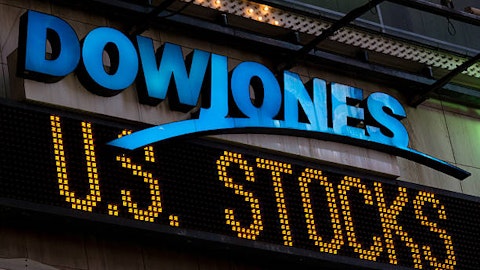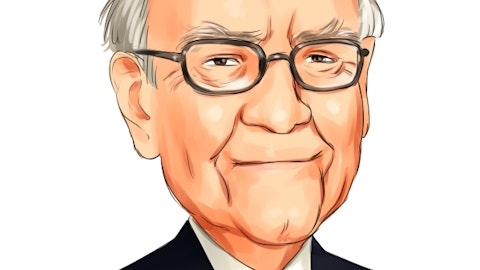American Express Company (NYSE:AXP) Q4 2023 Earnings Call Transcript January 26, 2024
American Express Company isn’t one of the 30 most popular stocks among hedge funds at the end of the third quarter (see the details here).
Operator: Ladies and gentlemen, thank you for standing by. Welcome to the American Express Q4 2023 Earnings Call. At this time, all participants are in a listen-only mode. Later, we will conduct a question-and-answer session. [Operator Instructions] As a reminder, today’s call is being recorded. I will now turn the conference over to our host, Head of Investor Relations, Mr. Kartik Ramachandran. Thank you. Please go ahead.
Kartik Ramachandran: Thank you, Donna, and thank you all for joining today’s call. As a reminder, before we begin, today’s discussion contains forward-looking statements about the company’s future business and financial performance. These are based on management’s current expectations and are subject to risks and uncertainties. Factors that could cause actual results to differ materially from these statements are included in today’s presentation slides and in our reports on file with the SEC. The discussion today also contains non-GAAP financial measures. The comparable GAAP financial measures are included in this quarter’s earnings materials, as well as the earnings materials for the prior periods we discuss. All of these are posted on our website at ir.americanexpress.com.
We will begin today with Steve Squeri, Chairman and CEO who will start with some remarks about the Company’s progress and results, and then Christophe Le Caillec, Chief Financial Officer will provide a more detailed review of our financial performance. After that, we’ll move to a Q&A session on the results with both Steve and Christophe. With that, let me turn it over to Steve.
Steve Squeri: Good morning, and thanks for joining us. 2023 was another strong year for American Express. We delivered record revenues of $61 billion for the year, up 15% on an FX adjusted basis, and we had a record net income of over $8 billion, with earnings per share of $11.21. In the fourth quarter, we continued to drive strong customer engagement and demand for our premium products. We had solid growth in billings, strong new account acquisitions, and continued strength in credit quality, which remains the best in the industry. As a result, we achieved fourth quarter revenues of nearly $16 billion, which was another quarterly record, and EPS was $2.62. Christophe will provide detail on our quarterly results, but I would like to take a step back to talk about what we’ve accomplished over the last two years until you — why I’m feeling good about where we are today and why I’m confident in our future.
Coming out of the COVID pandemic in January of 2022, we saw an opportunity to accelerate our growth, and we set in aspiration to sustain growth over the longer term at levels that were higher than what we were achieving prior to the pandemic. At that time, we laid out our growth plan with the objective of positioning the company to be able to deliver on our aspiration of driving annual revenue growth of 10% plus and mid-teens EPS growth over the long-term. In executing the plan, we focused on listening to our customers and understanding their needs, and we invested in innovating our value propositions, as well as uplifting our marketing and technology capabilities and backing our colleagues to meet those needs. Looking back over the two years since we announced the growth plan, I’m pleased to say that we achieved what we set out to do and in fact, we’re ahead of where we thought we’d be on our journey, thanks to the millions of premium customers we have around the world and the American Express colleagues, who support them.
Today, we are a larger and stronger company. Since 2021, we’ve delivered record annual revenues, increasing the scale of our business by over 40% in just two years from $42 billion to $61 billion in annual revenues — in revenues. Annual card spending over this period has increased 37% on an FX adjusted basis to a record $1.5 trillion. We’ve added about 25 million new proprietary card accounts over the last two years, and over 70% of these new accounts are coming into the franchise on fee-based products. With the growth and new accounts we’ve seen over the past few years, we now have a total of over 140 million cards running on our global network. Our focus on continuously innovating our value propositions to meet the needs of our customers is driving increased brand relevance across generations, including millennial and Gen Z consumers.
These customers represent over 60% of the new consumer accounts we acquired globally in 2023, and 75% of new consumer Platinum and Gold accounts acquired in the U.S. came from this cohort. At the same time, retention continues to be very high and our credit metrics remain strong and best-in-class. These strong results reflect the success of our strategic investments we’ve made in our business along with the tremendous earnings power of our business model. Looking ahead, let me tell you why I feel really good about our future prospects. We have a business model that is delivering premium performance, and we have strong momentum, which is driven by four key features of our model that differentiate us from the competition and are difficult to replicate.
First, our economic construct has a set of diversified revenue sources that include card fees, spending and best-in-class lending with our subscription-like card fees being a core and fast-growing component of our revenue mix. We have a singular focus on premium customers and superior innovative value propositions. Our premium customers are high-spending, loyal and drive our strong credit performance. We have a large and growing partnership ecosystem that expands our brand value to card members and merchant partners around the world, and we have a global brand and a servicing ethos that truly sets us apart. Our business model provides us with strong competitive advantages, and the way we’ve been able to leverage the model’s unique elements and execute our strategy has strengthened those advantages, giving us the runway for continuing our momentum across generations, geographies, and both our consumer and small-business customers.
The power of our business model combined with the global scale of our premium customer base, the dedication and focus of our talented colleagues, and the attractiveness of the many growth opportunities we see ahead are the key reasons why I’m confident in our ability to continue on our growth plan. And it’s why going forward, we will remain focused on our long-term aspiration of delivering annual revenue growth of 10% plus and mid-teens EPS growth. We believe this aspiration is the right one and we aim to achieve it every year. However, we manage the company for the long-term, and we anticipate there’ll be a range of potential outcomes in any given year due to a variety of factors such as external environment and actions we might take that we decide are best for the business.
Looking at this year, the continued momentum we’ve seen in the business as we’ve executed our strategy gives us confidence in our guidance for 2024, which is in line with our long-term aspiration. For the year, we expect to deliver annual revenue growth between 9% and 11%, and full-year EPS of $12.65 to $13.15. In addition, we plan to increase our quarterly dividend on common shares outstanding to $0.70 a share, up from $0.60, beginning with the first quarter 2024 dividend declaration. This represents more than a 60% increase in the dividend from when we introduced our growth plan in January of 2022. As always, we will continue to run our business for long-term, and we’ll do that by listening to our customers and meeting their needs through innovative, unique value propositions and exceptional service that reflects our brand built on trust and security, delivered and supported by a world-class colleague base.
In keeping our focus on backing our customers and our colleagues, we are confident that we will continue to deliver strong growth on a sustainable basis over the long-term. Thank you. And let me now turn it over to Christophe.
Christophe Le Caillec: Thank you, Steve, and good morning, everyone. It’s good to be here to talk about our 2023 results, which reflect another strong year of performance and to lay out our expectations for 2024. I will discuss both our quarterly and full-year results this morning. Since this year end and since looking at our business on an annual basis, it’s more in sync with how we run the company. Starting with our summary financials on slide two. Full-year revenues reached an all-time high of $60.5 billion, up 15% on an FX adjusted basis. Our fourth quarter revenues were $15.8 billion and grew 11% year-over-year. This revenue momentum drove reported full-year net income of $8.4 billion, and earnings per share of $11.21. For the quarter, we reported net income of $1.9 billion, and earnings per share of $2.62.
Let’s now go to a more detailed look at the drivers of these results, beginning with billed business on slide three. We reached record levels of spending for both the full-year and the fourth quarter in 2023. Total billed business grew 9% versus last year on an FX adjusted basis. In the fourth quarter, billed business grew 6% as we continue to see more stable growth rates after lapping the prior year impact of Omicron back in the first quarter. This 6% growth rate does reflect a bit of softening versus last quarter, but I would point out that the number of transactions from our card members continues to grow double-digits year-over-year, a good indicator of the engagement of our customer base. Our growth was driven by 5% growth in business services spending, and although slower than last quarter, continued strong growth in travel and entertainment spending up 9% for the quarter.

Restaurant spending remains our largest T&E category and reached $100 billion for the full-year for the first time, while airline spending growth slowed in the quarter. There are a few other key points to take away as we then break down our spending trends across our businesses, starting with our largest segment on slide four. U.S. consumer grew billings at 7% this quarter. We continue to see growth across all generations and age cohorts with millennials and Gen Z customers again driving our highest billed business growth within this segment. Their spending was up 15% this quarter. Looking at commercial services on slide five, overall growth came in at 1% this quarter, consistent with last quarter’s growth rate. Spending growth from our U.S. small and medium-sized enterprise customers remained modest given unique dynamics seen by small businesses over the past few years.
Specifically, in 2022, we saw a large increase in organic spending as businesses restocked their inventories following supply-chain issues during the pandemic. This caused a significant grow over challenged spending from this segment in the industry in 2023. Importantly, we continued to see strong levels of demand for new accounts, high levels of retention, and strong credit performance on our small-business products. Looking ahead, this positions us well for the future, a spending growth rebalance. And lastly, on slide six, you see our highest growth again this quarter in International Card Services. We continue to see double-digit growth across all regions and customer types. Spending from international consumers and from international SME and large corporate customers, each grew 13% in the fourth quarter.
Overall, while we’re seeing a softer spend environment, we are pleased with the continued strong engagement and loyalty of our card members across the globe. As we think about 2024, we are assuming a spend environment similar to what we’ve seen in the past few quarters. Now moving on to loans and card member receivables on slide seven. We saw a year-over-year growth of 13%. We expect this growth, which has been elevated versus pre-pandemic levels to continue to moderate as we progress through the 2024, but to still grow modestly faster than billings. Turning next to credit and provision on slide eight through 10. First and most importantly, we continue to see strong and best-in-class credit metrics. We attribute this performance to the high credit quality of our customer base, our robust risk management practices, and our disciplined growth strategy.
As we had expected, our write-off and delinquency rates did continue to tick up this quarter, as you see on slide right. Going forward, we expect to see this delinquency and write-off rates remains strong with modest increases in 2024. Turning now to the accounting of this credit performance on slide nine. The modest increase in our card member loans and receivables delinquency rate combined with the quarter-over-quarter growth loan balances resulted in a $400 million reserve build. This reserve build combined with net write-offs drove $1.4 billion of provision expense in the fourth quarter. As you see on slide 10, we ended the fourth quarter with $5.4 billion of reserves, representing 2.8% of our total loans and card member receivables and continuing to reflect the premium nature of our card member base.
This reserve rate remains about 10 basis points below the level we had pre-pandemic or day-one CECL. We continue to expect the reserve rate to increase a bit as we move through 2024, similar to the modest increases we’ve seen over the past few quarters. Moving next to revenue on slide 11. Total revenues were up 11% year-over-year in the fourth quarter and up 15% for the full-year on an FX adjusted basis. Our largest revenue line, discount revenue grew 5% year-over-year in Q4, and 9% for the full-year, as you can see on slide 12. This growth is mostly driven by the spending trends we discussed earlier. Net card fee revenues were up 17% year-over-year in the fourth quarter and 20% for the full-year, as you can see on slide 13. As we expected, growth continued to moderate a bit this quarter from the high levels we saw earlier this year, reflecting our cycle of product refreshes.
In 2024, we expect to exit the year with some further momentum compared to the current growth supported by continued product innovation and our focus on premium value propositions. We currently have plans to refresh around 40 products globally next year. In the quarter, we acquired 2.9 million new cards, and the spend revenue and credit profiles of our new cardmembers continue to look strong. Moving on to slide 14. You can see that net interest income was up 30% year-over-year on an FX-adjusted basis in Q4, and 33% for the full-year. This growth is driven by the increase in our revolving loan balances and also by continued net yield expansion versus last year. When you think about 2024, you should expect to see net interest income growth moderate as balance growth moderates, with some continued tailwind from our tenured customers continuing to rebuild balances.
And I would remind you that for our business model, we would not expect to see a meaningful impact from the lower interest-rate environment next year. To sum up, revenues on slide 15, the power of our diversified model continues to drive strong revenue momentum. Looking forward into 2024, we expect to see revenue growth between 9% and 11%. Moving to expenses on slide 16. Overall, total expenses were up 5% in the fourth quarter and 10% on a full-year basis, both growing significantly lower than revenue. This expense growth reflects the strong growth we’re seeing in our business, the investments we’ve made, as well as our continued focus on expense discipline. Starting at the top of the page with variable customer engagement expenses. These costs came in at 40% of total revenues for the fourth quarter and 41% for the full-year.
I would note that this cost came in a bit lower than our expectations, reflecting some of the natural hedges in our model. As T&E spend growth slowed a bit in the quarter, we saw lower rewards cuts than we had expected. For example, a lower mix of redemptions for airline’s tickets and fewer points earned on airline spend. In 2024, I would expect our variable customer engagement expenses to grow slightly higher than our revenue, as we continue to focus on our premium products and drive engagement from our card members. On the marketing line, we invested around $1.2 billion in the fourth quarter and $5.2 billion for the full-year. This is a bit below last year and our expectations to have marketing spend at around $5.5 billion. Marketing expense came in lower than we expected for the quarter, reflecting lower demand given the softer T&E environment.
However, we saw demand increase as we moved through the quarter and we continue to plan for increased marketing spend in 2024. We are confident that with our sophisticated acquisition engine will do so in an efficient way. Moving to the bottom of slide 16 brings us to operating expenses, which were $4.2 billion in the fourth quarter and $14.9 billion for the full year 2023. This was above our original expectations, driven by a few notable items in the quarter. First, as part of the normal course of business, we set up a reserve to cover expenses as we continuously look to enhance the organization’s effectiveness. We also set up a reserve for exposure to a specific merchant, and like many others, we were impacted by the devaluation of the Argentine peso, which increased our OpEx in Q4 by $115 million.
Looking forward, we continue to see OpEx as a key source of leverage, and our focus on delivering low levels of growth as we have historically done. In 2024, we expect operating expenses to be fairly flat to this year’s expense. We will of course continue to assess opportunities as we move through the year, and our flexible model will allow us to dial up or down investments as needed. Taking everything into account in 2024, we expect total expense to grow mid to high-level digits for the full-year, as we expect to drive continued leverage through our operating expenses. Turning next to capital on slide 17. We’ve returned $5.3 billion of capital to our shareholders in 2023, including $1.4 billion in the fourth quarter on the back of strong earnings generation.
We ended the year with our CET1 ratio at 10.5%, within our target range of 10% to 11%. In Q1 2024, as Steve discussed, we expect to increase our dividend by over 15% to $0.70 per quarter, consistent with our approach of growing our dividend in line with earnings, and our 20 to 25 target payout ratio. We plan to continue to return to shareholders the excess capital we generate, while supporting our balance sheet growth. We do not expect any material near-term changes to our capital management approach. That brings me to our long-term aspiration and 2024 guidance on slide 18. We continue to run our business with a focus on our aspiration of revenue growth in excess of 10%, and mid-teens EPS growth, and we believe that is the right aspiration.
As Steve discussed for the full-year 2024, specifically, we are reducing our guidance of having revenue growth of 9% to 11%, and earnings per share of between $12.65 and $13.15. This guidance remains in line with our aspiration and also factors in a range of scenarios based on what we’re seeing in our business today. We also recently announced an agreement to sell our Accertify business. Our guidance and the items related to 2024 that I just walked through, do not include the potential impact from this sale. We do expect to realize a sizable gain on the sale and to reinvest a substantial portion of the gain back into our business, as we’ve done with similar transactions in the past. We expect the deal to close in the second quarter and plan to provide more detail then.
With that, I’ll turn the call back over to Kartik to open the call for your questions.
Kartik Ramachandran: Thank you, Christophe. Before we open up the lines for Q&A, I will ask those in the queue to please limit themselves to just one question. Thank you for your cooperation. And with that, the operator will now open up the line for questions. Operator?
See also 20 States Where You May Not Be Able to Retire at Age 65 and 30 Most Affordable Beach Towns to Live in the US.
Q&A Session
Follow American Express Co (NYSE:AXP)
Follow American Express Co (NYSE:AXP)
Operator: [Operator Instructions] Our first question comes from Don Fandetti of Wells Fargo. Please go ahead.
Don Fandetti: Hi, good morning. Did you say the ’24 EPS guidance and rev guidance? I guess on January spend, some of your peers have noted a slowdown on weather. Can you comment on that, and then just maybe talk a little bit about billed business in ’24 in terms of SME?
Christophe Le Caillec: Yes. So we don’t talk about monthly numbers so let alone about you know a few weeks into the month of January. So, I think best is to wait until the end of quarter, and we’ll provide a lot more color and detail on the billing in January so far. As far as how we think about billed business in 2024, our planning assumption is that we should expect or we expecting billings to be consistent with what we’ve seen in the prior few quarters, you know, and we are ready to see in a society if there is some. But for now, that’s the assumption we have baked in our plans and how we constructed this guidance. On the SME side, it’s the same, assumption if you want. We are assuming either something similar to what we’re seeing in Q3, Q4, and you know we are very focused on winning the recoveries with SMEs. As I’ve said in my remarks, these card members have been through a lot over the last two, three years, and we are focusing on providing the best experience, the best products.
We are focusing on acquiring as many customers as we can and helping them grow their business. And we’ll be ready when they’re ready. Historically, this has been a volatile segment for us. You know, how dynamic these customer segments are and we play a critical role in that industry and we’ll be ready when they’re ready.
Operator: Thank you. The next question is coming from Ryan Nash of Goldman Sachs. Please go ahead.
Ryan Nash: Hey, good morning, guys.
Steve Squeri: Good morning.
Ryan Nash: Maybe to build on Don’s question. Can you maybe just dig a little bit deeper on some of the drivers of revenue growth, so discount revenues, card fees, and Christophe, I know you said that NII should decelerate then. Are we assuming any sort of re-acceleration as we move through the year, particularly in areas like U.S. Consumer or SME? Thank you.
Christophe Le Caillec: Yes. Hey, good morning, Ryan, and thank you for your question. So the building blocks of the revenue growth remain the same. At a fairly high-level, we expect billing and therefore discount revenue to grow at a pace similar to what we’ve seen in the recent quarters. We expect card fees — so Q4 is at 17%, full-year at 20%, we expect card fees to be a key contributor to growth going forward — to remain a key contributor to growth going forward, and actually to exit Q4 at a higher level than where we are right now. And I gave you the context in my remarks, very much supported by the constant strength in premium acquisition, their product refresh and renewals that we are committed to execute on, and very strong retention rates, which we have experienced for many years now.
And when it comes to the last either component of our revenue pool, net interest income, you should expect that growth rate to moderate very much driven by the fact that — and you’ve seen the trend, I’m sure, Ryan, there you know asset growth and their lending growth rate has been moderating over the past quarters and we expect that moderation to continue. The very strong growth was a function of tenured card members rebuilding balances post-COVID, and you know at some stage we’re going to reach there — a more normal rate there and that will naturally drive NII new to a more moderate level of growth. I’m going to also mention that we believe that the interest-rate dynamic in what the Fed will design doesn’t play a big role here in terms of what’s going to happen to NII.
And when you put all of this together and you can — you know, we run multiple scenarios what if billing is a bit stronger, what if you know NII is a bit weaker, and we land in the same range of 9% to 11%. So that’s very much how we think about that the revenue guidance.
Operator: Thank you. The next question is coming from Mark DeVries of Deutsche Bank. Please go ahead.
Mark DeVries: Yes. Thanks. I was hoping you could dig a little further into kind of where the loan growth is coming from, how much of it is from new customers or relatively recently added customers versus older and gaining share there, and also whether you’re seeing any kind of difference in credit performance on kind of balances from newer customers versus older.
Christophe Le Caillec: Okay. So let me take loan growth first. The dynamic on loan growth has not changed, and for several quarters now it’s also our philosophy and how we run the company. About 70% of their loan growth comes from tenured card members, and what we call tenured card members is card members who’ve been with us more than 12 months. And that’s very much how we think about acquisition. We acquire card members. We develop relationships with them. Then we offer them — you know, we cross-sell products, we increase alliance, we nurture those relationships, and we do that because we understand them better, we understand their spend patterns and they understand our products better as well. And that’s the driver. There either we don’t do much balanced transfers, if any at all, and we don’t have promotional offers — much promotional offers also.
So it’s very much growing with our tenured card members. And it’s part of our strategy to contain if you on the credit risk and to control it. And when it comes to the credit profile of the new card members, we haven’t changed our credit underwriting models, right? We still — and we haven’t changed as well our marketing channels and products. Well, we still skew towards positive selection in terms of credit profile. That has not changed and I need to say that there prospects that we bring in and become recent card members have very good credit profile.





